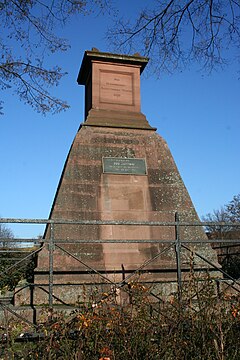| Battle of Seckenheim | |||||||
|---|---|---|---|---|---|---|---|
| Part of Bavarian War (1459–63) | |||||||
 Memorial to Battle of Seckenheim, 30 June 1462 | |||||||
| |||||||
| Belligerents | |||||||
|
|
| ||||||
| Commanders and leaders | |||||||
|
|
| ||||||
| Strength | |||||||
| 3,100+ | 6,000-8,000 | ||||||
| Casualties and losses | |||||||
|
12 knights killed many grooms killed |
40+ knights killed 327 captured | ||||||
The Battle of Seckenheim (June 1462) saw the army of the Electoral Palatinate led by Frederick I, Elector Palatine and his ally Dieter von Isenburg face an invading army led by Charles I, Margrave of Baden-Baden, Ulrich V, Count of Württemberg, Louis I, Count Palatine of Zweibrücken, and George of Baden, the Bishop of Metz. Without warning, Frederick suddenly struck at the invaders, trapping them in the fork of two major rivers. Though about 300 knights cut their way out, causing many non-combatant casualties, the Palatine forces were victorious. Frederick captured three of the enemy leaders and wrung ransoms and territorial concessions from them. Seckenheim is now part of the city of Mannheim in the state of Baden-Württemberg, Germany. The combat occurred during the Mainz Feud (Mainzer Stiftsfehde), part of the larger Bavarian War (1459–63).